For many years, we got used to the fact that the packaging of a product is merely a structure that protects the product against damage during storage or transport. An additional function of the packaging is to draw the potential customer’s attention to the product and encourage them to buy it through graphic design, catchy advertising slogans, examples of use or description of the product’s advantages. In recent years, in the era of rapid development of technology and digitization, more and more objects around us are referred to as smart. This trend has also affected the packaging industry that increasingly utilizes smart technologies.
Smart packaging is a relatively new category of packaging that has built-in sensors, electronics and software that allows it to interact with products, consumers, and logistics systems. These packages are designed to reduce product losses, increase logistics efficiency, improve food safety, or provide a better user experience. Smart packaging can measure temperature, humidity, pressure, and even track the location and movement of the product or the time of its use. This data can then be transferred to various systems that enable better control of product quality and safety. So, the main function of smart packaging is to collect and process data. Smart packaging can include QR or RFID or NFC codes (scanned with a smartphone) that allow consumers to get more information about the product. On smart packaging, there are also interactive marketing elements that attract consumers’ attention, for example, using augmented reality. Smart packaging may also contain security-related elements, such as anti-theft or anti-tear features.
Smart packaging has many applications in various industries. In the pharmaceutical industry, they can help monitor the temperature and humidity of drugs, which is extremely important for their effectiveness. In the food industry, they can be used to monitor food quality and ensure that food is stored under the right conditions to prevent spoilage or even predict an expiration date. Thanks to this, producers can improve the quality of their products and increase customer loyalty, and consumers can be sure that they are buying a high quality and safe to eat product. In the logistics industry, they can help monitor the location and movement of products, as well as track shipments, which facilitates warehouse management and prevents unnecessary costs.
Smart packaging is also good for the environment. Thanks to the ability to monitor and optimize the supply chain, they can prevent or reduce product waste. They can also help prevent counterfeiting and fraud, which allows brand protection and consumers can be more confident about the quality and authenticity of products. In addition, sensors built into the packaging allow monitoring of the condition of the product and the environment in which it is located.
Packaging with an RFID code is a packaging equipped with an RFID (Radio Frequency Identification) tag, which is a special electronic component capable of storing data and communicating wirelessly with RFID readers using a radio wave. RFID tags are increasingly used in the food, pharmaceutical and logistics industries to identify and track products in real time. The RFID code on the packaging may contain information important to the customer, such as the name of the manufacturer and product, logo, composition, date of production, storage conditions or shelf life, which significantly speeds up the processes of identification and inventory of products at the place of their distribution or sale. RFID codes can also be used as anti-theft tags.
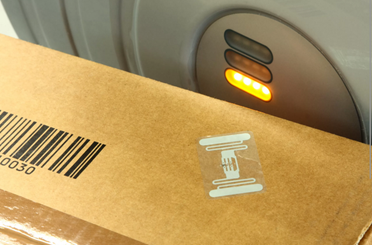
Figure 1 . An example of a package with an RFID code, source
Packages with a QR code (Quick Response) are packages equipped with a special two-dimensional code that can be read using a smartphone with appropriate software. QR code packaging is widely used in the food, pharmaceutical and cosmetic industries to provide easy access to product information for customers and consumers. With the help of QR codes, you can get information about the product’s composition, nutritional values, best before date, storage tips and much more. A QR code can store all sorts of information, such as product website addresses or direct contact information. QR code packaging can increase consumer awareness of products, as well as provide easier access to product information, which can help increase brand trust.
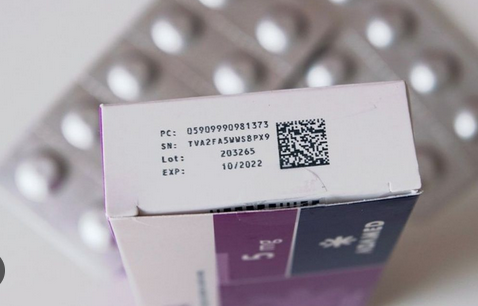
Figure 2 . An example of a package with a QR code, source
Augmented Reality (AR) packaging is packaging that allows you to display additional information, animations, product visualizations and other elements using AR applications on smartphones or tablets. AR allows for an interactive presentation of the product in a way that is simply not feasible using traditional packaging. Thanks to AR packaging, it is possible to increase customer engagement and stand out on the market. AR can be used to present a virtual visualization of the product, animation of the packaging, advice on use or showing how the product can be used in practice. AR packaging is increasingly popular in the beauty, food, fashion, and electronics industries, where customers can easily scan the packaging and see how the product will look or function before purchasing.
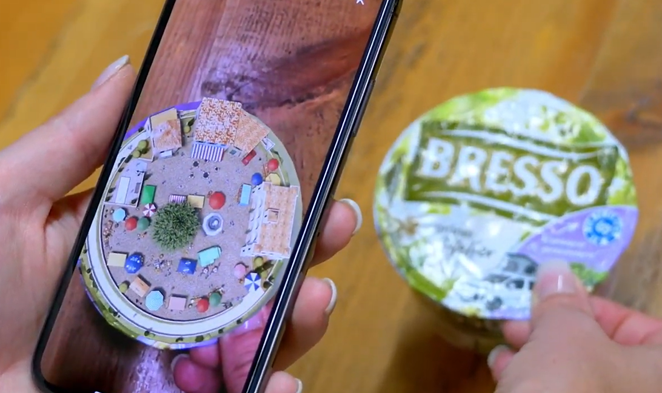
Figure 3 , Example of packaging using AR, source
Packaging with an NFC (Near Field Communication) code is a packaging equipped with a special NFC tag that allows communication with NFC devices without the need for an Internet connection. NFC tags allow to easily and quickly share data wirelessly near the receiving device. NFC coded packaging can be used in a variety of industries including food, pharmaceutical and cosmetics to provide easy access to product information on ingredients, nutrition, best-before date, storage tips, and more. In addition, packaging with an NFC code can be used for other purposes, such as contactless payments, opening doors or launching mobile applications, which can increase the functionality of the packaging and facilitate the use of the product. The NFC technology on the packaging can be integrated into the material of which the box itself is built, thanks to which the customer, by bringing the phone closer to the packaging, can obtain more information about the product by connecting directly to the manufacturer’s website.
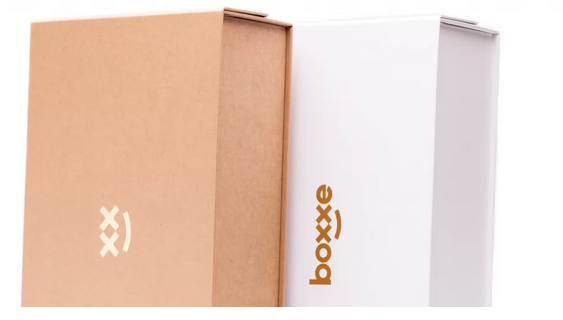
Figure 4 , example of packaging with NFC technology, source
A leak indicator package is a package that has a special indicator that tells the user if the package has been damaged. Such an indicator may be in the form of a special label, tape or seal that changes color or texture when the package is tampered with. Leakage-indicating packaging is used in various industries, primarily in the food and pharmaceutical industries, where it is important to ensure product safety. If the leak indicator is broken or has changed color, it may show that the package has been damaged or has been exposed to improper storage conditions, which may affect the quality of the product. Leakage-indicating packaging is particularly useful for products that require tight protection, such as medicines, food, and cosmetics. Leakage indicators react to changes in the properly modified atmosphere around the product, i.e., to the undesirable presence of oxygen and carbon dioxide in the package. An example is the Ageless Eye oxygen detector. It conveys information to the consumer by changing the color. It remains pink in the absence of oxygen and turns blue in the presence of oxygen within a few minutes.
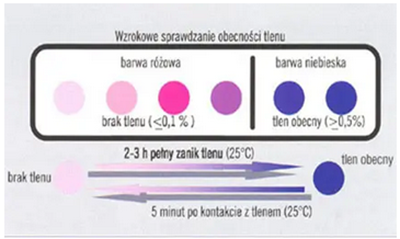
Figure 5 , Example of a package with a leak indicator, source
Freshness indicator packaging is packaging that tells consumers how fresh the product is inside. The freshness indicator can take many forms, for example a label, sticker or special stripes that change color or texture over time. Freshness indicator packaging is especially important for food products that have a short shelf life, such as meat, fish, vegetables, or fruit. With freshness indicator packaging, customers can accurately monitor how long a product has been stored and when it should be consumed to avoid ingesting stale or spoiled food. Additionally, packaging with a freshness indicator can help prevent food waste. Freshness indicator packaging is also used in other industries such as cosmetics and pharmaceuticals. Thanks to packaging with a freshness indicator, manufacturers can increase consumer confidence in their products and contribute to reducing waste. Freshness indicators work on the principle of detecting metabolites (enzymes, amines, sulfur dioxide, toxins, hydrogen sulphide, organic acids, ammonia) produced by harmful microorganisms propagating in the product. These can be indicators with a ring insert placed inside it from the packaging side, which change color on the thermometric scale with the increase in the concentration of the amines formed. In the fruit and vegetable industry, product maturity indicators are used, in which sensors can be placed in the label interacting with the aromas emitted from the fruit during ripening.
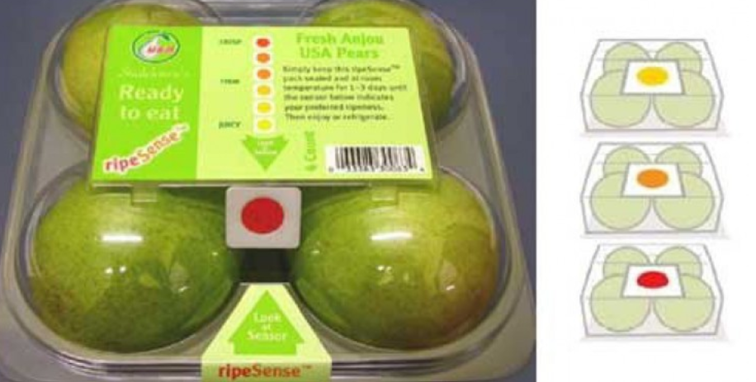
Figure 6 , Example of a package with a freshness indicator, source
A package with a time and temperature indicator is a package that allows you to monitor the time and temperature at which the product has been transported or stored. Time and temperature indicators can come in various forms, for example labels, stickers or special strips that change color or texture depending on the time or temperature at which the product has been stored. For example, if a product has been exposed to a temperature above a certain level, the indicator changes color to inform the user that the product may have been damaged or spoiled. In the indicators, a polymerization reaction may occur as a result of which the inner circle darkens.

Figure 7 Figure 7. Example of a package with a time and temperature indicator, source
An interesting example of smart packaging is the solution from the patent document US20090294521A1 for an interactive container for medicines. This container has an information strip that informs the patient about prescriptions and drugs and reminds them when to take them. In addition, it tracks and collects information such as consumption time or information on how often the package is opened.
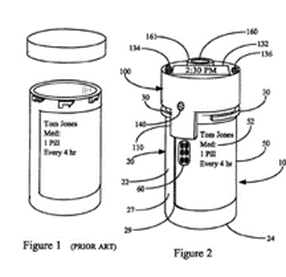
A similar solution to the above is the solution from the patent document US20160120758A1, i.e., a bottle for tablets equipped with sensors for detecting the presence or absence of pills, removing the bottle cap, and having a communication module for wireless communication with an external device and Internet services. The web service sends appropriate notifications and reminders to authorized users.
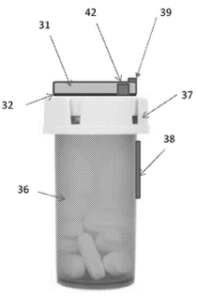
In summary, smart packaging has immense potential and many benefits for consumers, producers, and the environment. They contribute to better quality and safety of food, medicines and cosmetics, improvement of logistic efficiency and environmental protection.




